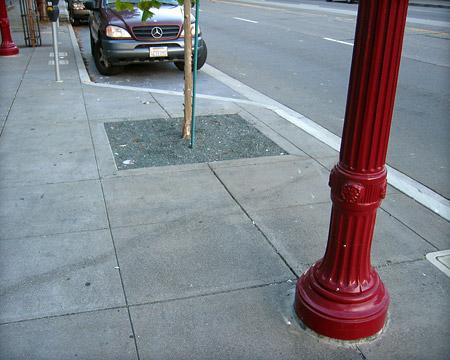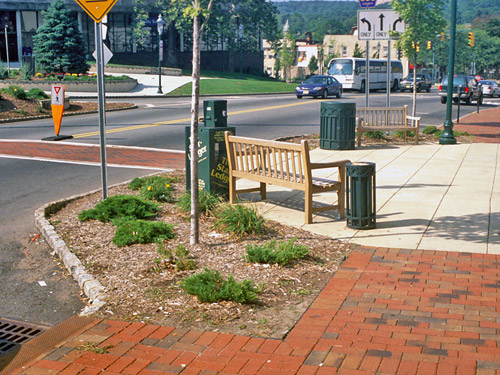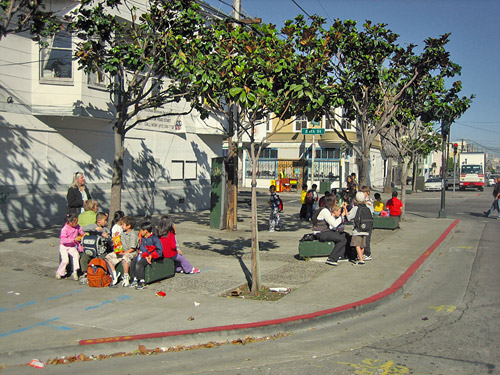See also Traffic Calming Overview
Curb extensions (also called bulb-outs) extend the sidewalk into the parking lane to narrow the roadway and provide additional pedestrian space at key locations; they can be used at corners and at mid-block. Curb extensions enhance pedestrian safety by increasing pedestrian visibility, shortening crossing distances, slowing turning vehicles, and visually narrowing the roadway.
Generally, these benefits are greater the further the bulb-out extends into the roadway and the tighter the turn radius created by the bulb-out, but should be balanced against roadway characteristics and the needs of large vehicles to navigate turns.
Curb extensions can often be lengthened to create public spaces, landscaped areas, or transit waiting areas. They can also be employed as neck-downs or chokers, traffic calming techniques that reduce vehicle travel lanes.
Curb extensions can have the following benefits:
- Increased pedestrian visibility at intersections through improved sight lines
- Decreased pedestrian exposure to vehicles by shortening the crossing distance
- Reduced vehicle turn speeds by physically and visually narrowing the roadway
- Increased pedestrian waiting space
- Additional space for street furnishings, plantings and other amenities
- Reduced illegal parking at corners crosswalks and bus stops
- Facilitated ability to provide two curb ramps per corner
Although curb extensions have many benefits, they may not be appropriate in all circumstances. Use of curb extensions should consider the following:
- They may be more expensive to construct than other measures
- They can reduce flexibility of the roadway in construction routing
- They can reduce future flexibility in making changes to the location of bus zones, roadway lane layout, or crosswalks
Bulb-outs should also be considered as one among many strategies to enhance pedestrian safety and streetscape character; in some cases, median refuges, raised crossings, other improvements, or a combination of strategies may be more appropriate.
Process Overview
Curb extensions may be installed as part of a traffic calming project or other public or private initiative.
For curb extensions as part of a traffic calming project, see Traffic Calming Overview
Official sidewalk curb lines are established by Board of Supervisors Ordinance #1061, “Regulating the Width of Sidewalks.”
Bulb-outs or sidewalk widening on one block or less can be administratively approved by DPW, with input from other agencies. Projects involving bulb-outs or sidewalk widening on more than one block require legislative approval by the Board of Supervisors.
Traffic calming devices require approval by an SFMTA hearing officer. Additionally, if the project would result in a change to certain parking or traffic designations, it may require approval by the SFMTA Board.
Official Codes & Documents
- Better Streets Plan (street design guidelines)
- SFMTA Traffic Calming Guidelines
- DPW Standard Plan for Curb Bulb
Design Guidelines
Placement
Street Types: All
Sidewalk zones: Extension zone
Specific priority areas for curb extensions include:
- New streets
- Streets with high pedestrian volumes and/or high traffic volumes and speeds
- Wide streets with long crossing times
- Streets with a history of pedestrian safety concerns
- Locations where neighborhood streets intersect with busier throughways
- Transit priority streets where shortening crossing cycles would improve transit flow
Lower priority areas for curb extensions include streets with lower pedestrian and traffic volumes and lower speeds, such as neighborhood residential streets and alleys. However, they may be considered on these street types as well.
Curb extensions should not be used on streets without a parking lane, or that have a peak period tow-away parking lane.
Curb extensions may be placed at transit stops per transit stop guidelines. Where curb extensions are provided at transit stops, they should be a full-length transit bulb, and not a standard corner bulb, as it can be difficult for a bus to exit or re-enter traffic around a corner bulb-out.
Guidelines
Bulb-outs should be designed to maximize pedestrian space and minimize crossing distances as much as feasible, while allowing vehicle movements as described in the curb radius guidelines.
Width and length
Bulb-out width should be maximized based on space for adjacent vehicle and bicycle travel lanes (see Figure 1). The bulb-out should extend to the full width of the parking lane or leave:
- 10 feet for the nearest auto travel lane
- 11 to 12 feet for the nearest travel lane if it is a transit lane
- 12 feet for the nearest travel lane if it is a designated freight route or industrial street
- 5 feet or the full width of any adjacent bicycle lanes
Typical Bulb-Out Dimensions
Before reducing the width of the proposed bulb-out, consider modifications to lane striping across the entire roadway to provide for the above-listed clearances. Since bulb-outs are often expensive to construct, they should be sufficiently wide to maximize their benefit. Bulb-outs less than 4 feet in width may not be a cost-effective solution as compared to other potential interventions.

Where bike lanes are present, curb extensions should be set back so that the gutter pan does not extend into the bike lane.
Curb extensions should not encroach on cyclists’ space. Where bike lanes use a painted inside edge, the bike lane should be painted continuously as the bike lane passes the curb extension, and the bulb-out should be set back so that the gutter does not extend into the bike lane. On lower speed and volume streets where bikes can travel in mixed flow with vehicles, wider curb extensions may be appropriate, but care should be taken not to force cyclists to merge unexpectedly with faster moving cars at the end of the block. If bulb-outs extend beyond the limit of parked cars, additional efforts should be made to ensure their visibility.
Bulb-outs should continue at least to the inside edge of the crosswalk, and ideally extend 5 feet beyond the property line before beginning to return to the curb to provide additional width for pedestrians, landscaping, or other streetscape features. Existing driveways may cross through bulb-outs.
Radii
Curb extensions should follow all curb radius guidelines. Where turn radii make adding bulb-outs at each corner prohibitive, strive for two bulbs per intersection, kitty-corner to each other, in order to improve pedestrian conditions for all four crossings of an intersection.
Curb extensions should return to the prevailing curb line as sharply as possible to maximize useable space and minimize parking loss, per the following guidelines:
Standard return: Standard bulb-outs should be designed with an inner/outer curb radius of 20’ and 10’, sometimes reduced to 15’ and 10’, to enable street sweeping machinery to sweep the entire curbline.
Non-standard return: Sharper curb returns increase pedestrian space and minimize parking loss while better defining a curb extension. However, they are more difficult and costly to maintain. Where maintenance funding or agreements are in place to account for this, designs may consider the non-standard treatments described below:
- 90 degree return: Curb extensions may return to the prevailing curb line at a 90 degree angle. This configuration may be used with parallel or perpendicular parking.
- 45 degree return: Curb extensions may return to the prevailing curb line at an angle. his may be used with either parallel parking (45 degree return) or angled parking (at angle of parking lane).
Shape
Bulb-outs should strive for a rectilinear shape to keep a direct path of travel and to regularize crossings and curb ramps. The adjacent figures show alternative bulb-out shapes with the same turn radius. The figure at left provides greater overall space for pedestrians waiting to cross the street, which may be useful at impacted locations. The figure at right provides more clear directionality and direct curb ramps, as well as a tighter corner. Both alternatives are acceptable; the resulting design should be balanced with the overall goals of the project.
Bulb-Out Shape Alternatives
Other design features
Bollards, planters, or other fixed objects may be placed at the back of curb where necessary to protect pedestrians and prevent vehicles from driving onto the sidewalk.
Where curb extensions will be added, they should be reviewed by DPW Hydraulics to ensure that there is sufficient hydraulic capacity within the street cross-section. Stormwater features can help to offset reduced capacity from curb extensions.
Curb extensions may require relocation of corner catch basins.
Generally, fire hydrants must be located within 18-24″ of the curb face for visibility, which often means relocating a hydrant when a project will change an existing curb line. However, per agreement with the San Francisco Fire Department, in locations where only bulb-outs are being constructed (as opposed to locations where an entire block face will be widened), fire hydrants may remain in their existing location (aligned with the prevailing curb line), reducing the cost of constructing the bulb-out.
Extended Bulb-Outs
Longer curb extensions may be considered to create space for seating, landscaping, stormwater features, and other amenities, particularly in areas lacking in open space.
Extended bulb-outs should use special paving or an edging treatment to distinguish the space as a plaza space separate from the through travel area. Street furnishings and other above-grade objects should be located on curb extensions outside of crossing areas to increase space for pedestrian through travel on the sidewalk.
Mid-Block Bulb-Outs
Mid-block bulb-outs may be considered on all street types to provide additional sidewalk space for landscaping, seating, stormwater treatment, and amenities, and improve safety at mid-block crossings by shortening crossing distances and enhancing pedestrian visibility. Mid-block bulb-outs should follow these guidelines:
- They should include bollards, landscaping, or other buffers between pedestrians and passing vehicles, designed to not impede a driver’s view of pedestrians.
- They should use special paving or an edging treatment to distinguish the space as a plaza space separate from the through travel area.
- Street furnishings and other above-grade objects should be located on curb extensions where space allows, increasing space for pedestrian through travel on the sidewalk.
- Mid-block curb extensions should be used at designated mid-block crossings. Mid-block crosswalks should be provided per crosswalk guidelines.
Maintenance
Maintenance Responsibilities
With some exceptions, fronting property owners are responsible for the on-going maintenance and upkeep of sidewalk paving as well as all sidewalk elements directly fronting their property, such as trees, landscaping, and streetscape furnishings. Generally, the City is responsible to maintain roadway paving and other features in the roadway, such as medians.
For curb extension projects initiated through a traffic calming project, see Traffic Calming Overview: Maintenance.
For a more detailed description of maintenance responsibilities, see Maintenance














 Copyright © 2015
Copyright © 2015